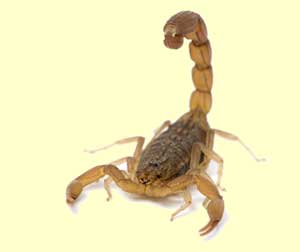Spider Venom
Venomous Spiders: Cytotoxic Venom
Cytotoxic venom effects the tissue that is destroyed around the bite and considerable tissue damage can ensue. Lesions of up to 10 cm in diameter may develop. The symptoms develop gradually and often the person is unaware that he has been bitten until the area around the bite becomes painful. It is therefore usually difficult to ascertain the spider species that has delivered the bite, particularly since it often takes place at night. In Southern Africa three genera are of particular medical importance.
Two genera, Cheiracanthium and Loxosceles produce cytotoxic venom and are medically important in Southern Africa. The venom of a third genus Sicarius, found mainly in the drier regions, has a combination of cytotoxic and haemotoxic components. However no proven cases of human envenomation are known in South Africa and clinical evidence is inconclusive.
violin spiders
six-eyed crab spiders

Violin spiders (SICARIIDAE: LOXOSCELES)
Violin spiders usually live in grassland and in caves with only one species introduced into houses on the Witwatersrand. Violin spiders are nocturnal and at night may find their way into, for example, clothing, beds and shoes. To date no antivenom has been produced, and although no death has been reported in Southern Africa, plastic surgery is sometimes necessary to repair tissue damage. Violin spiders are usually brown or reddish brown in colour, with dark markings on their bodies. They have characteristic violin-shaped markings on the cephalothorax and are quite often confused with daddy-long-legs, which are not venomous.
SYMPTOMS AND SIGNS OF VIOLIN SPIDER BITES
spider venom:The superficial bite is painless and initially goes unnoticed. About 2 hours after the bite a red swollen lesion, sometimes with a purple centre develops. Over the next day or two bleeding into the site causes a blackened lesion. By day 4 the swelling and inflammation subside, while cutaneous necrosis continues to spread slowly. Necrotic tissue sloughs off leaving a deep ulcerating wound which is slow to heal and leaves a nasty scar.
TREATMENT
Treatment should focus on preventing and treating secondary infection using local antiseptics and systemic antibiotics to promote healing. Ulcers are managed conservatively through cleaning and dressing. Timely surgical cleaning may arrest a rapidly spreading lesion. Dapsone treatment in low doses for 14 days may control extension of the ulceration. Disfiguring scars may require reconstructive surgery with skin grafting at a later stage. The patient should receive a tetanus toxoid booster.

SpiderVenom
The scorpions do not go looking for their prey or pursue them for several minutes at full speed; they just wait. With the help of their sensory hairs located in the legs, they can perceive the vibrations of small animals that are part of their diet, and then they hasten to hide or camouflage expecting that the victim approaches close enough to attack it.
spider venom
There are 2 types of spiders found in the United States that can cause illness in people. One type is the widow spider. The black widow is the best known. The other type is the recluse spider. The brown recluse is the best known. A bite by either type usually is not deadly, but it may make a person very sick. It’s important to get quick medical help if you think you’ve been bitten by either type of spider.
-Treatment
spider venom:If you are bitten by either a black widow or brown recluse, see your healthcare provider right away or go to the emergency room. Antivenin is available for black widow bites, but none is available for brown recluse bites. The antivenin is only used in the most severe cases. Other treatment is mostly to ease symptoms. The site of the bite should be cleansed and cold packs applied. Tetanus shots should be given
Recluse spiders. There are 12 species of recluse spiders, including the brown recluse, in the United States. Only half of these are responsible for bites that have a major reaction in people. Most of the spiders in this group have a violin/fiddle-shaped markings on the upper part of their body with the base at the front of the head and the neck of the violin pointing towards the rear of the spider. Besides the brown recluse, the other poisonous spiders in this group can be gray, orange, reddish-brown or pale brown. Like the black widow, the recluse spiders like quiet, dark, undisturbed areas in and around the home. They are nighttime spiders, so they come out mostly at night or when the light is dim.
spider venom















